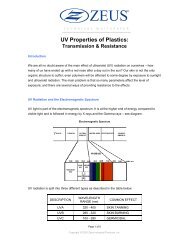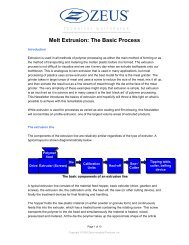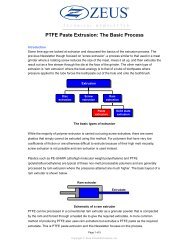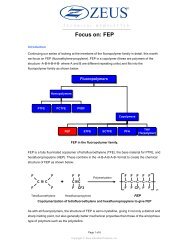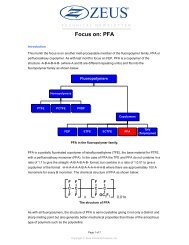Crystallinity in Plastics - Zeus Industrial Products, Inc.
Crystallinity in Plastics - Zeus Industrial Products, Inc.
Crystallinity in Plastics - Zeus Industrial Products, Inc.
You also want an ePaper? Increase the reach of your titles
YUMPU automatically turns print PDFs into web optimized ePapers that Google loves.
Melt<strong>in</strong>g behavior<br />
Crystall<strong>in</strong>e polymers have dist<strong>in</strong>ct melt<strong>in</strong>g po<strong>in</strong>ts (Tm). At this po<strong>in</strong>t, the crystall<strong>in</strong>e regions<br />
break up and short-range order is lost. However, <strong>in</strong> amorphous polymers, regions tend to<br />
soften over a wide temperature range.<br />
Shr<strong>in</strong>kage 1<br />
Shr<strong>in</strong>kage of plastics products after process<strong>in</strong>g is common, but crystall<strong>in</strong>e and amorphous<br />
polymers shr<strong>in</strong>k differently. All plastics parts shr<strong>in</strong>k after process<strong>in</strong>g simply as a result of their<br />
compressibility and the thermal contraction as they cool from the process<strong>in</strong>g temperature.<br />
With amorphous plastics, this is the only factor and is easily calculated. But because<br />
crystallites conta<strong>in</strong> more ordered and better pack<strong>in</strong>g of the polymer cha<strong>in</strong>s, phase transition<br />
<strong>in</strong>creases shr<strong>in</strong>kage considerably.<br />
For amorphous polymers, shr<strong>in</strong>kage values are not only low, but shr<strong>in</strong>kage itself is quick to<br />
occur. For a typical amorphous polymer such as PMMA, the shr<strong>in</strong>kage will be <strong>in</strong> the order of<br />
0.001 - 0.005 m/m. This is due to cool<strong>in</strong>g from about 150ºC (the temperature of the melt) to<br />
23ºC (room temperature) and can be related to the co-efficient of thermal expansion.<br />
Shr<strong>in</strong>kage is 90-95% complete immediately after process<strong>in</strong>g and 100% complete with<strong>in</strong> 3 to 4<br />
hours 2 .<br />
Crystall<strong>in</strong>e polymers are not only affected by compressibility and temperature shr<strong>in</strong>kage but<br />
also by crystallization shr<strong>in</strong>kage. As the polymer solidifies, crystals form and the improved<br />
pack<strong>in</strong>g leads to shr<strong>in</strong>kage values far greater than those seen <strong>in</strong> amorphous polymers. For a<br />
typical crystall<strong>in</strong>e polymer such as PP, shr<strong>in</strong>kage will be <strong>in</strong> the order of 0.01 - 0.025 m/m. This<br />
is between 5 to 10 times the shr<strong>in</strong>kage of an amorphous polymer. Only about 85% of this<br />
higher shr<strong>in</strong>kage will have taken place <strong>in</strong> the first 24 hours, about 98-99% will have taken<br />
place <strong>in</strong> the first week and the rema<strong>in</strong><strong>in</strong>g shr<strong>in</strong>kage may take up to 3 months to complete.<br />
Generally, about 85% of shr<strong>in</strong>kage occurs <strong>in</strong> the first 24 hours and 98-99% has taken place <strong>in</strong><br />
the first week. The rema<strong>in</strong><strong>in</strong>g shr<strong>in</strong>kage may take up to 3 months to complete. In such cases,<br />
it is normal to anneal the molded article for a short time at the maximum crystallization<br />
temperature to force the polymer to equilibrium where full shr<strong>in</strong>kage can take place with<strong>in</strong> an<br />
hour.<br />
This variable shr<strong>in</strong>kage effect means that process<strong>in</strong>g tolerances achievable for amorphous<br />
polymers are far better than those for crystall<strong>in</strong>e polymers.<br />
1<br />
For a more complete discussion of shr<strong>in</strong>kage <strong>in</strong> plastics parts see: www.tangram.co.uk/TI-<br />
Polymer-Shr<strong>in</strong>kage_<strong>in</strong>_plastics.html<br />
2<br />
Other factors, such as part geometry, orientation and mold<strong>in</strong>g parameters have been<br />
ignored <strong>in</strong> this simple explanation.<br />
Page 8 of 9<br />
Copyright ©2007-2010 <strong>Zeus</strong> <strong>Industrial</strong> <strong>Products</strong>, <strong>Inc</strong>.




